Take Weird Ideas Seriously
Weird Ideas as Individual Alpha and Societal Necessity
Welcome to the 1,763 newly Not Boring people who have joined us since our last essay! Join 253,725 smart, curious folks by subscribing here:
Today’s Not Boring is brought to you by… Silicon Valley Bank
We are living through of one of the most interesting periods in startup history. Revenue is growing faster, rounds are bigger, funds are bigger, and companies are burning billions. Some categories are red hot and others can’t buy a bucket.
That’s why I found SVB’s new State of the Markets H2 2025 report so fascinating. It highlights a complex and uneven recovery across tech. While some sectors are experiencing renewed growth, others face persistent challenges with stagnant deal activity, depressed valuations, and limited exits.
50% of VC-backed tech companies having less than a year of cash remaining. Series A companies burn $5 to generate every $1 of revenue. One-third of US VC investment has come from deals involving the six largest funds. Things are changing fast.
Hi friends 👋,
Happy Thursday!
We haven’t done a weird essay (or a short one) in a little while, so with Halloween mere hours away…
Let’s get weird.
Take Weird Ideas Seriously
Jeova Sanctus Unus was an alchemist.
Before his death in 1727, he spent thirty years attempting to discover the vegetative spirit that made things grow and transform. He built furnaces, repeatedly mixed and heated various substances, and carefully recorded observations on color changes, crystallization patterns, and reactions between metals and acids. Over the course of those three decades, he would fill his notebooks with over one million words on the subject.
His family was so embarrassed by the work that when he died, they hid the notebooks. They didn’t want Jeova Sanctus Unus to destroy the reputation of the man who wrote under that pseudonym. His real name was Isaac Newton.
I love this story, because alchemy is a weird idea, wrong in hindsight, without which Newton probably never would have made the discoveries he did in mathematics and physics.
Those ideas were weird, too, at the time.
The idea that gravity could act through empty space was considered absurd and occult by contemporaries like Leibniz. Newton was comfortable with it because alchemy assumed sympathies and antipathies between substances acting on each other invisibly across space.
The idea that atoms were mostly void with small solid cores was controversial at the time, and ultimately right. But it was logical to someone who believed in the subtilization of matter and the need for space for spirits to operate.
Newton believed that matter wasn’t inert, that it contained active principles, an idea lifted directly from alchemy. He proposed that particles had forces between them, laying the groundwork for chemical affinity theory and ultimately for atomic forces.
Calculus, which he discovered around the same time as Leibniz, is the mathematics of change, as alchemy was meant to be the science of transformation. Newton’s fluxions described continuous change in a way that mirrored alchemical processes.
His belief in the universal spirit, a subtle medium permeating space, presaged field theory. His attempts to multiply gold, and therefore understand how small amounts of matter could catalyze larger changes, preceded catalysis. His obsession with the sacred geometry in the proportions of Solomon’s Temple influenced his mathematical work on harmonic series.
Perhaps Newton’s greatest contribution was the pursuit of unified principles – explaining all motion with Three Laws, and all gravity with one equation - which rhymed with the alchemists’ quest for the Philosopher’s Stone, the one thing that explained all transformation.
Newton was the physicist he was because he took weird ideas seriously.
The people who change the world are the ones who take weird ideas seriously. Even if you don’t plan to change the world, taking weird ideas seriously is a more interesting way to live.
Notice that I didn’t write “believe all weird ideas” – that’s just gullibility – or “accept weird ideas because others don’t” – that’s blind contrarianism.
Taking weird ideas seriously means that when you encounter an idea – from others, or from insight – that others would dismiss or may never have thought of in the first place, you study it with the same rigor you’d apply to more standard ones. It means not dismissing ideas simply because they’re weird.
Of course, there are a lot of weird ideas out there. Most of them are wrong. You will probably waste your life if you chase every weird idea that comes across your desk.
But sometimes a weird idea grabs you, feels particularly true and especially important.
When that happens, you should follow that weird idea as far as it leads you. You should take it as seriously as you’d take a conventional idea, and probably more so.
On an individual level, weird ideas are alpha.
I am a true believer in differentiation, for people and for companies. Weird ideas are a source of differentiation. “If you only read the books that everybody else is reading,” wrote Haruki Murakami, “you can only think what everyone else is thinking.” This is particularly true as more people turn their thinking over to AI.
One of the best ways to be different is to feed your brain different ideas, and let it really chew on them. Go deep. Read books no one else is reading. Speak with people no one else is speaking to. Give yourself time and space offline, disconnected, to let your ideas take their own shape. Make connections between your new weird ideas and normal ideas.
Personally, I have been going deep down the non-local consciousness rabbit hole. The last book I read was LSD and the Mind of the Universe. I’m not the only person interested in these ideas – religions have been on them for millennia - but they make an interesting pairing with tech and Vertical Integrators. As a direct result of this intersection, I’ve written essays like The Return of Magic and Means and Meaning. I’m also probably much more bearish than a typical VC on the idea that scaling data and compute will somehow lead to an intelligence equal, or even superior, to ours. I also think there will be tremendous opportunities in figuring out how to enhance our innate human superpowers. Mostly, I’m just continually fascinated by how magical the universe is.
On the individual level, though, there’s a risk. Because most weird ideas are wrong, chances are that the weird idea that grabs you is wrong, too. You might spend months, years, or decades chasing something that turns out to be a dead end.
You should take that risk anyway. Not because you’ll necessarily be vindicated, but because pursuing an idea that grabs you transforms how you think about everything else. Newton’s alchemy was incorrect, but it made him Newton.
What’s more, humanity needs you to pursue your weird ideas, even if they’re wrong.
On the societal level, weird ideas are how we avoid getting trapped in locally stable but globally suboptimal equilibria.
For how readily we dismiss new ideas and those who nurture them, there is a surprising amount of theory backing up this claim.
Every complex adaptive system faces a choice: explore or exploit. Do you optimize the thing that’s already working (exploit) or seek altogether better alternatives (explore)? Even when exploitation is currently more rewarding, the math suggests that optimal strategies always maintain some exploration. Exploration comes from individuals taking weird ideas seriously.
Take, for example, the AI race. We are largely in the exploit phase: make tweaks around the transformer architecture, add a lot more energy, and a lot more GPUs. The algorithms and GPUs keep getting better, on the same track.
While many believe this is the path to ASI, to me, it feels like a climb to a local maximum.
In 1989, Stuart Kauffman released a paper examining The NK model of rugged fitness landscapes. You can think of a rugged fitness landscape like a mountain range with peaks of different heights. If you’re climbing a smaller hill, improvements can get you to the top of that hill, the local maxima, where you get stuck. Any move you make takes you back down the hill; you’re trapped.
Kauffman is a theoretical biologist, so the work in that paper applied to biology, specifically evolution. He showed computationally that to escape local maxima and reach global maxima, two things are needed: sexual reproduction and modularity. Sexual reproduction means taking half a solution from one peak, half from another, and seeing what happens. Because DNA is modular, can be broken into chunks, different traits can be separately optimized, and then mixed and matched to form new traits. Mutations play a role, too. Most fail, but they create variation, and over enough attempts – enough new combinations with some mutant spice mixed in – variation increases the probability of reaching global maxima.
To jump to higher peaks, we need both the raw material of weird ideas and the willingness to combine them with traditional ideas in new ways.
Two recent examples come to mind.
Just yesterday, a Not Boring Capital portfolio company called Extropic announced a new prototype x0 chip that uses Thermodynamic Sampling Units (TSUs) instead of GPUs with a goal of ultimately decreasing the energy required to run new thermodynamic models by 10,000x. The idea is to use naturally occurring thermal noise to get probability distributions for free. That the announcement came on the day that NVIDIA became the world’s first $5 trillion company is beautifully poetic.
This is a weird idea, an attempt to explore instead of exploit, and to combine insights from two fields to come up with something new and potentially better. Having worked in quantum computing at Google, Extropic co-founder Guillaume Verdon, better known as Based Beff Jezos, struggled alongside the rest of the quantum field to eliminate thermal noise (random electron fluctuations). What if, instead, you use those fluctuations? Instead of fighting the natural randomness in circuits, Extropic treats it as a feature. The electrons generate probability distributions for free, making probabilistic computing, which is a large part of what AI is, vastly more energy-efficient. Extropic takes ideas from both quantum and classical computing, and combines them in a way that looks weird.
Pursuing weird ideas isn’t easy. People reject weird ideas. Beff has caught endless heat from internet anons. Now, he’s shipping. The team is on a path towards converting energy into intelligence much more efficiently, and enabling new sorts of models altogether. It is one potential way out of AI’s local maximum.
It’s too early to tell exactly which types of models and capabilities thermodynamic computing will open up, but this is one of the benefits of weird ideas: they open up what Stuart Kauffman calls the Adjacent Possible.
The Adjacent Possible says that you can only discover what’s adjacent to where you already are. Alchemy opened possibilities in physics that pure mechanics never would have. You need weird leaps to open up new adjacencies. The weird idea makes other ideas thinkable. It expands the search space.
Often, innovation comes from connecting distant domains. Weird ideas are often imports from different fields. Newton brought alchemy into physics. Jobs brought calligraphy into computing. Extropic is bringing quantum into classical. Weird ideas have high betweenness centrality. They connect previously disconnected parts of the knowledge graph, expanding the Adjacent Possible and enabling novel recombinations. This is what is meant by “ideas having sex.”
What’s funny is that while Kauffman wrote The NK model of rugged fitness landscapes to describe biological systems, he could just as easily have been explaining the field of biology.
In 1953, Watson & Crick published the structure of DNA. That discovery established the “central dogma” of biology: DNA → RNA → Protein. Biology essentially became molecular biology. Genes encode information. Development is genetic program execution. Evolution is changes in DNA sequences. If you want to understand something, sequence it. More generally, biology became biochemistry. The past 70 years in biology, including much of the work in AI for Bio, has been spent climbing to the top of this hill.
To suggest anything different is at play would be weird. If biochemistry can’t explain something yet, we just need better tools for understanding biochemistry.
But what if…
Since the 2000s, Michael Levin at Tufts University has been pursuing a weird idea: that bioelectric patterns are a higher-level control system. What if organisms are less like machines executing genetic programs and more like collective intelligences solving problems?
From near the molecular biology peak, this looks like a step backwards. Bioelectricity looks like “vitalism,” the old and thoroughly debunked idea that there was a vital force driving living things. A superstition no longer needed thanks to modern biochemistry.
Levin’s work, however, has worked.
He makes flatworms grow heads in the wrong places by manipulating ion channels instead of genes. He creates xenobots, frog cells that self-organize into novel forms that can’t exist in nature. He induces eye formation in tadpoles in places eyes never grow, just by tweaking voltage gradients. He causes tumors to form in frog embryos by disrupting their bioelectric patterns and prevents them from forming by normalizing bioelectric signals. A couple of weeks ago, he even proposed that aging is the result of loss of goal-directedness.
Two-Headed Flatworm, Levin Lab
It seems that there is something very important to bioelectricity. By jumping off of one hill, Levin has been able to both open up new frontiers in biology and mine that frontier for a stunning amount of new, adjacent ideas.
Now, thanks to Levin Lab’s results, bioelectricity is emerging from the weird shadows into the mainstream. I met a founder this week building bioelectric tools to heal humans. While biochemistry clearly plays an enormous role in how living things operate, understanding that it might not play the only role will expand our understanding of our bodies, and our ability to improve them.
I think Levin will win a Nobel Prize for this work one day. If he does, he will join a long list of Laureates whose work was initially dismissed as too weird.
In the 1940s and 1950s, Barbara McClintock discovered that genes could move within chromosomes. She called them jumping genes. Jumping genes were so ridiculed that she stopped publishing for decades. Then she won the Nobel Prize in Physiology or Medicine in 1983 at age 81.
In the 1980s, Barry Marshall proposed that bacteria (H. pylori) caused stomach ulcers, not stress or spicy food. The medical establishment rejected the idea. He drank a beaker of bacteria to prove it, gave himself ulcers, then cured them with antibiotics. He won the Nobel Prize in Physiology or Medicine in 2005.
In 1982, Dan Shechtman discovered crystals with “impossible” five-fold symmetries, called quasicrystals. An eminence no less than Linus Pauling rejected the idea. “There are no quasicrystals,” he quipped. “Only quasi-scientists.” Shechtman was asked to leave his research group. He won the Nobel Prize in Chemistry in 2011.
Pauling may have been scarred by his experience with his own weird ideas. In the 1970s, Pauling, the only human to ever win two unshared Nobel Prizes, became obsessed with vitamin C curing everything from colds to cancer. He was largely wrong. Vitamin C couldn’t do everything he expected, but perhaps because he believed the prize was so large, he took it seriously enough that he sparked serious research into antioxidants, nutrition’s role in disease, and orthomolecular medicine. Something like one-third of all American adults report taking Vitamin C at least occasionally today.
I realize that I have mostly provided examples of history’s great scientists, which isn’t particularly aspirational for people like me, who are not history’s great scientists, but that is mainly to show that even the greats can have correct weird ideas that are rejected in the moment, and that even the greats can have incorrect ideas that still nonetheless nudge humanity forward. Important weird ideas, though, are not limited to science.
My favorite contemporary example of how to take weird ideas seriously is Jesse Michels, who runs the popular YouTube channel, American Alchemy.
Jesse operates in a different mode than the scientists we’ve discussed so far. The weird ideas he takes seriously aren’t his. Instead, he serves as a credibility bridge between people making claims that others would dismiss as too weird – like alien abductions and anti-gravity - and the mainstream. A couple of weeks ago, he hosted Dan Sherman, who claimed that the NSA trained him to communicate with aliens.
What I love about Jesse’s work is that had I heard this story anywhere else, I might have dismissed it. But since I’ve seen how seriously Jesse takes weird ideas – doing deep research on the ones he sees as credible, debunking unsubstantiated claims, and making connections among seemingly disparate, independently-crazy-sounding but mutually-substantiating ones – I’m willing to suspend disbelief and take anything he shares seriously.
And because Jesse has approached these ideas with a seriousness that few others in the mainstream have, he’s been able to build a very large platform (individual alpha) and contributed, I think, to pushing humanity off of a comfortable local maximum and towards a higher one.
My thinking is richer for taking it seriously, too, even if it may seem a little bit offbeat. One of the things I’ve been thinking a lot about is how disconnected the ideas that I’m taking most seriously seem.
Complex, vertically integrated startups and non-local consciousness don’t seem to have much to do with each other on the surface. It’s a weird combination, and may not be a combination at all. But both feel very important to me. They’re pulling me. One says that we can improve the means available to humanity if we’re willing to build new solutions from the ground up, and the other says that improving the human condition has meaning, that there is a point and a direction to all of this.
In my mind, it forms the beginnings of a worldview that is almost the exact opposite of the one taking hold in Silicon Valley. That humans are miraculous, and that far from spelling the end of human supremacy, climbing to AI’s local maximum will signal the endpoint of the left-brain materialist era by demonstrating that there’s magic beyond the reach of even the smartest machines. There is a big universe out there, and many more hills for humanity to climb.
I don’t know. It’s a weird idea.
That’s all for today. We’ll be back in your inbox tomorrow with a Weekly Dose. If you’re looking for something to read in the interim, check out SVB’s State of the Markets H2 2025 report.
Thanks for reading,
Packy


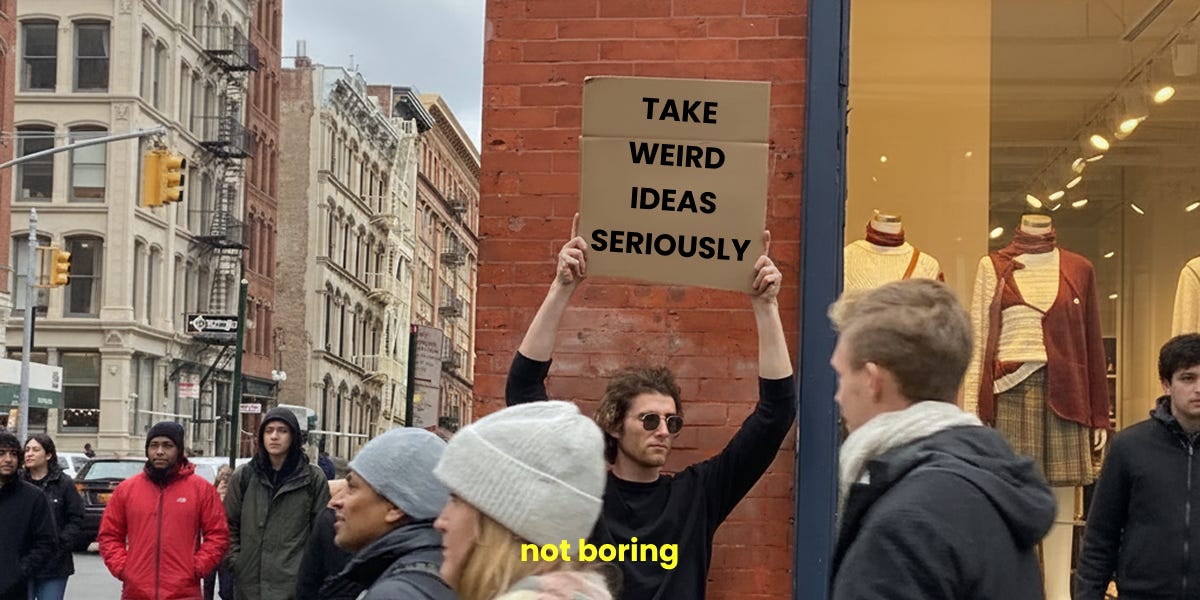

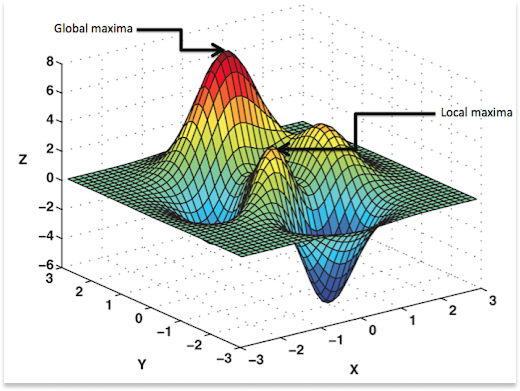
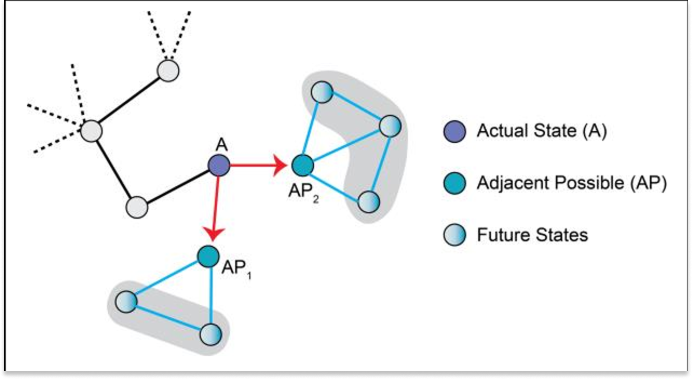

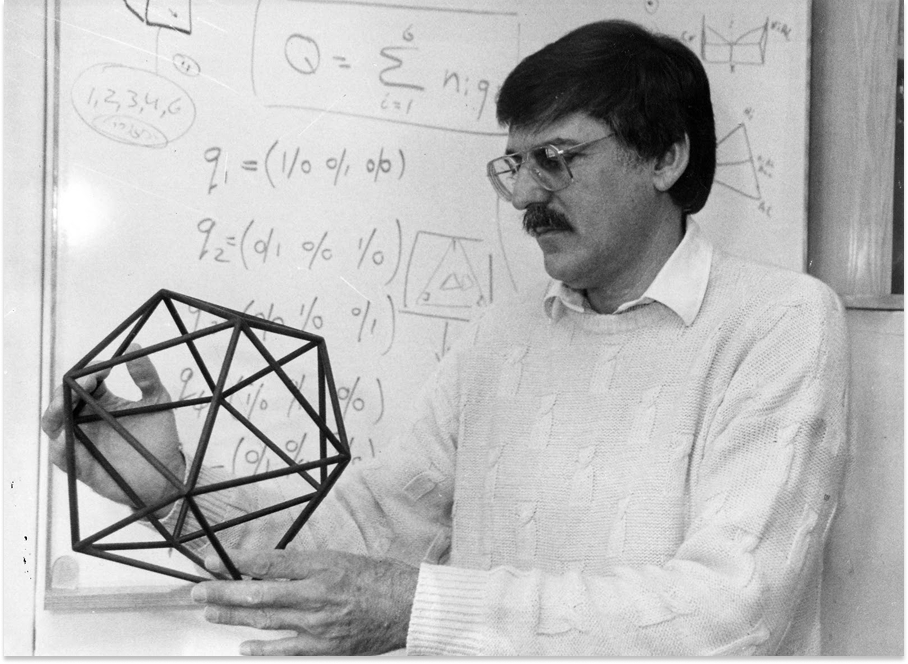
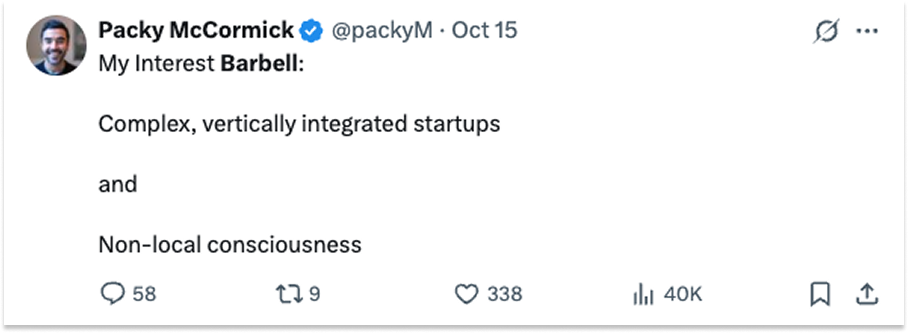
Great write. Thank you 🙏 love the idea of giving more cred to weird / unconventional ideas ❤️
Love this perspective. Taking weird ideas seriously is crucial; often the true value is in the rigorous process of exploring them, not just the initial novelty.